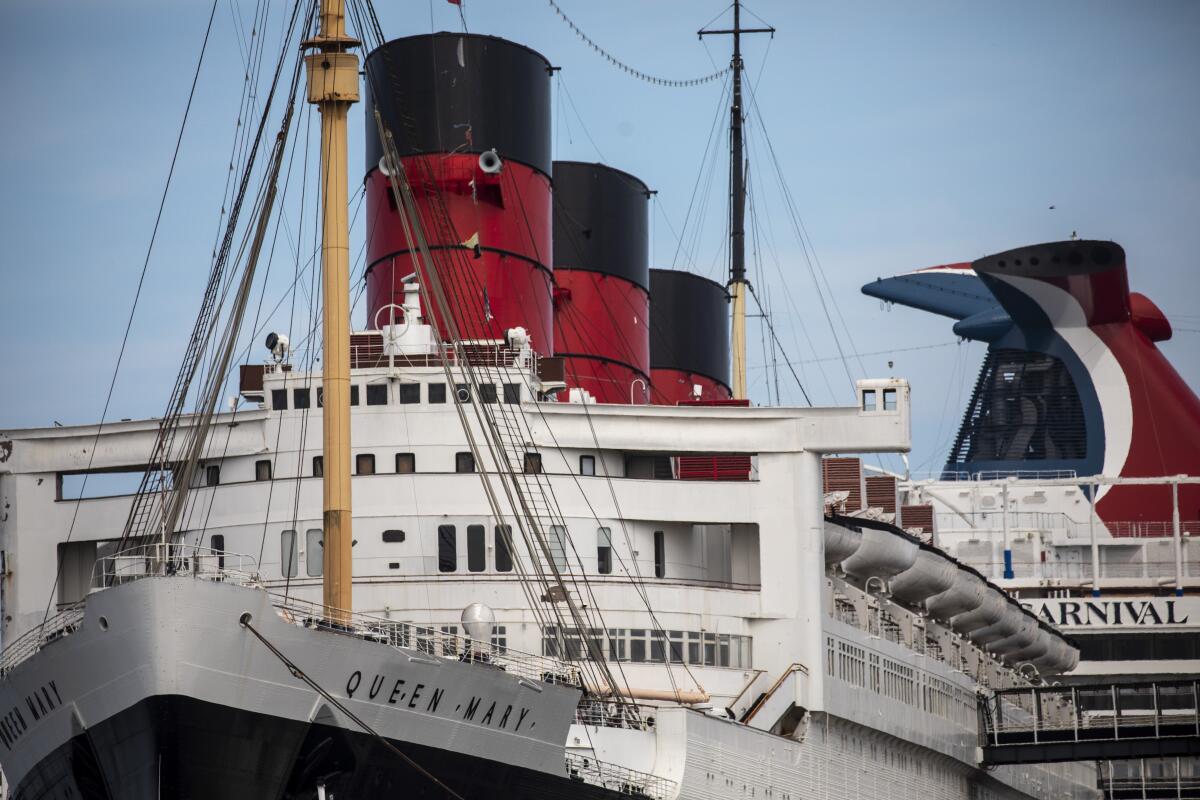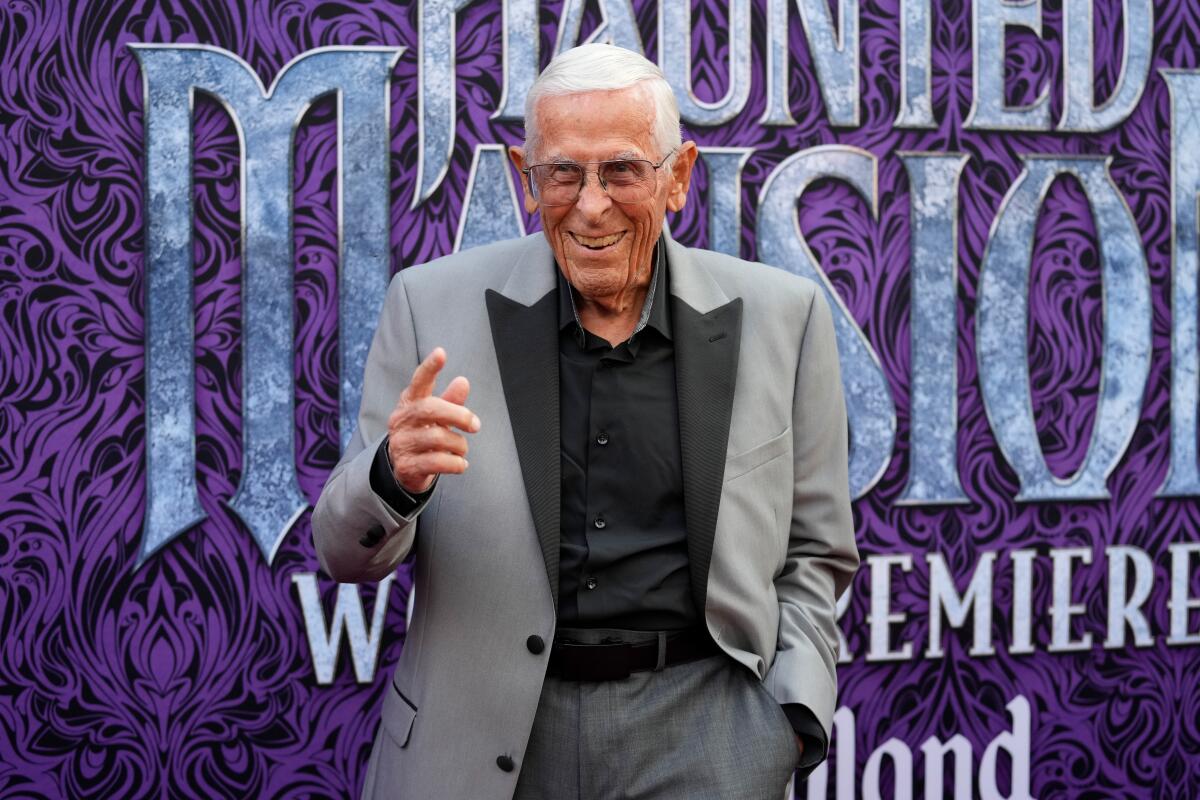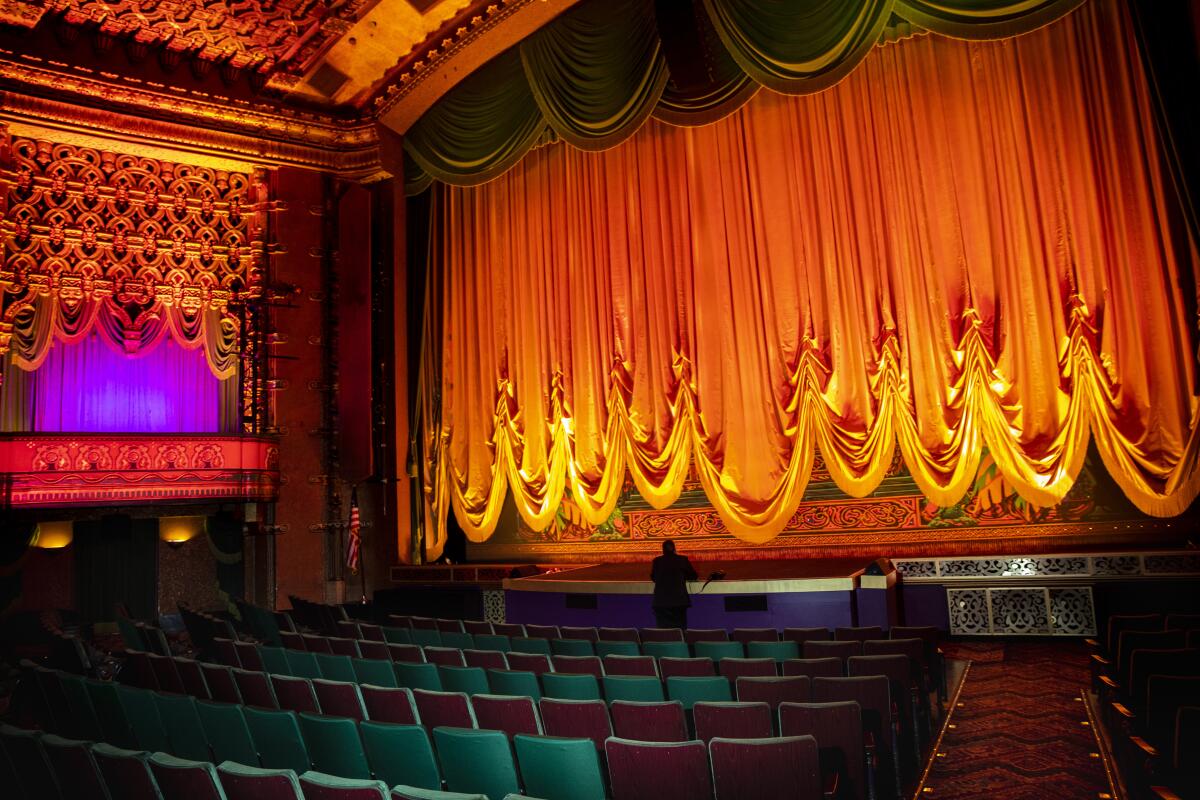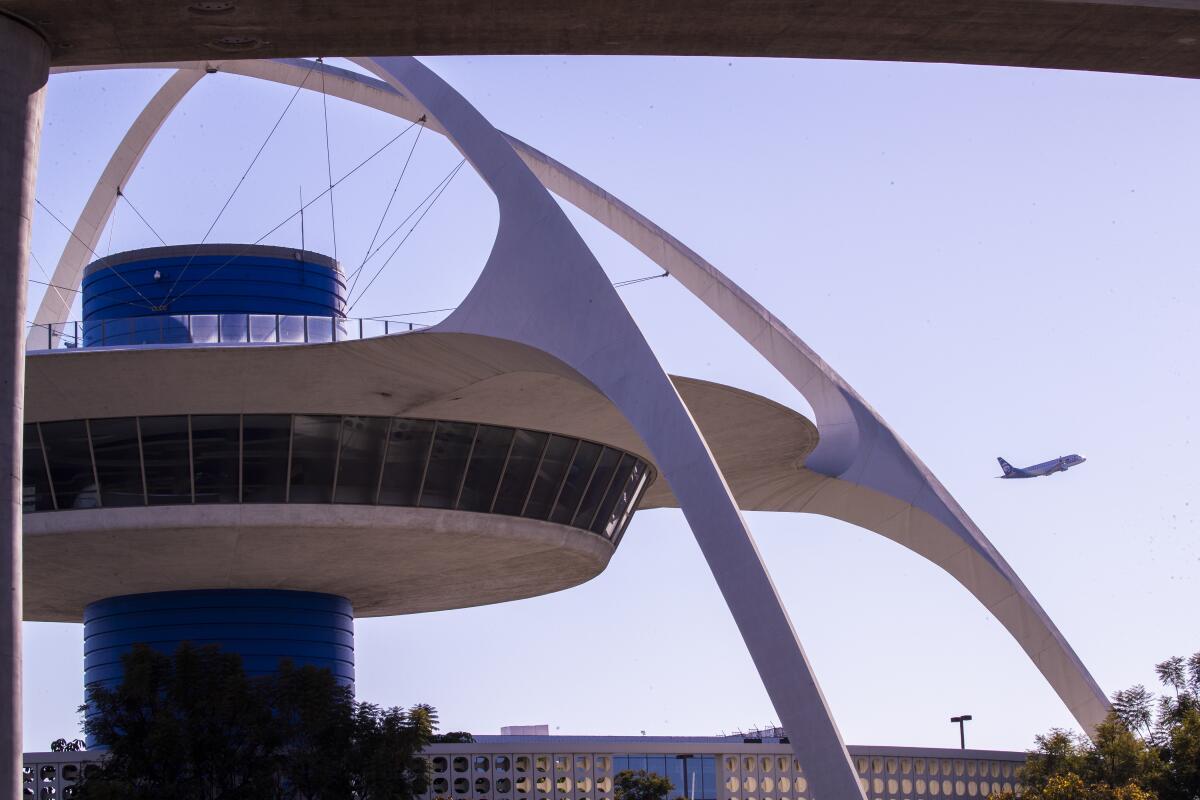14 places in L.A. that every Disney lover must visit at least once
- Share via
Walt Disney history is closely intertwined with Los Angeles. There is a reason, after all, that the entrance area of Disney California Adventure is modeled after the Los Feliz neighborhood.
Disney relocated here from Kansas City, Mo., in the early 1920s, and would go on to create an empire that helped define American pop culture. It was while living in Los Feliz and working on the nearby Kingswell Avenue that he laid the groundwork for what would become a giant of entertainment. And there’s evidence that he loved the area, frequenting its restaurants and Griffith Park.
Planning your weekend?
Stay up to date on the best things to do, see and eat in L.A.
Today, while millions travel yearly to the Disneyland Resort, there are bits of Disney history — and Disney magic — scattered throughout Los Angeles. They can be found, for instance, in a skate shop, at a prime rib destination or even a small bakery and places of nature. Some give us a glimpse into who the man was; others are lasting remnants of the ways in which Disney and its artists have touched our city.
We skipped private residences and movie locations on this list in favor of more public locales, but note that some spots may require making arrangements in advance.

Discover Disney's love of trains inside Walt's Barn
In 1950, Disney built a miniature railroad in the backyard of his home in the Holmby Hills area of L.A. He and those he hosted were able to ride the train throughout the grounds, which famously included a tunnel under his wife’s flower bed. The barn that was the center of so much of Disney’s train operations now lives in Griffith Park, and is lovingly preserved by the Carolwood Society.
Consider it a small museum dedicated to Disney’s love of trains. You’ll see an original Disneyland passenger car, now outfitted with historic toys, photographs and early Disneyland train paraphernalia, including re-creations of what Disney’s backyard train — the Carolwood Pacific Railroad — looked and felt like. There’s usually a short wait to get inside the 832-square-foot barn, home to a host of ephemera, including a phone Disney used to communicate from the barn to the home and the train’s track controls.
Yet the star of the show today is a heavily detailed model train of one of Disneyland’s early attractions, the Mine Train Through Nature’s Wonderland.
The Mine Train moved out to make way for Big Thunder Mountain in the 1970s, so Walt’s Barn is really the only way today to experience a taste of the ride. The original attraction featured more than 200 animatronics and took guests on a journey through, under and around rainbow caverns and towering peaks. The Mine Train closed in 1977, but its mining town of “Rainbow Ride” lives on in Big Thunder Mountain.
Walt’s Barn is open the third Sunday of each month from 11 a.m. to 3 p.m. It’s free, but a small donation is appreciated.

Walk in Walt's footsteps at the original Disney Bros. Studio location
They called their operation the Disney Bros. Studio, and it was officially the formation of what would become the Walt Disney Co. At the Kingswell space, Disney pursued his passion for animation with his “Alice Comedies” film series, shorts that followed a young live-action girl performing in “Cartoonland.” A total of 56 “Alice Comedies” were made between 1924 and 1927.
In September 2024, a small strip on the corner of Kingswell and Vermont avenues was officially designated the Disney Bros. Cartoon Studio Square. Come for photos in front of the placard, but don’t leave before visiting the Kingswell skate shop, owned by retired pro skateboarder D.J. Chavez.
The space, says Chavez, is regularly visited by tour buses, and he welcomes all Disney fans, whether they skate or not. A portion of the shop’s wall, pictured above, has been dedicated to the history of the Disney Bros. Studio, and he even sells some Kingswell-branded gear that nods to the space’s Disney roots.
Chavez says he finds it motivating to be in the same spot were Disney got his L.A. start. “It’s inspiring in every way, shape or form,” Chavez says.
“It’s just sick to be in this teeny little space that created this mega-monster,” Chavez says. “If he can do it, then it inspires me to try everyday, especially living and breathing in the same air that he did at one time.”
The success of the “Alice Comedies” allowed Walt and Roy in 1926 to move to a larger spot on nearby Hyperion Boulevard, although that location has long since been torn down. Disney moved to Burbank in 1940.

These pastries at the Original Martino's Bakery were once a Disney studio staple
Burbank’s the Original Martino’s Bakery, which dates to 1926, has long been serving the community and its bounty of nearby studios. Yet in the 1940s, as documented in the book “Eat Like Walt” from historian Marcy Carriker Smothers, Martino’s was a supplier for the Inking & Painting Tea Lounge at the Walt Disney Studios.
Martino’s tea cakes, little square buttermilk cupcakes, with just a hint of vanilla and a soft sugary glaze, were a signature item at the lounge. The cafeteria catered to the largely female team of “inkers” and “painters,” who traced and painted finished animating drawings on transparent cels. Smothers notes it was tea rather than coffee that was served at the lounge for fear that the high caffeine content of the latter could make a hand shake.
The lounge is long gone, but Martino’s tea cakes remain a Burbank delicacy forever associated with the Disney Studios.

Visit the real tree that inspired the lush Adventureland Treehouse
Passed-down lore persists that one day Walt Disney stopped by the fig tree and asked permission to photograph it. While what is myth and what is fact is sometimes hard to discern when it comes to the creation of Disneyland, historic Disney site Yesterland has attempted to untangle the roots of the story, even posting pictures of the very real tree side-by-side with the resort’s fictional one. According to Yesterland, park designers created molds of knots from Anaheim’s Moreton Bay fig, and today the park in which it resides, Founders’ Park, also home to various historic Anaheim houses, boasts a plaque proudly proclaiming the tree’s connection to Disneyland.
Founders’ Park is a short 10-minute drive from Disneyland, so it’s an easy visit if the Adventureland Treehouse is on your list of must-do Disneyland attractions. And it should be, as the treehouse was updated in 2023 with an original tale full of cute mechanical animals and clever, abstract storytelling that invites exploration.

Take a tour of the Walt Disney Studios
A centerpiece of the 2½-hour tour — open only to members of the Disney fan club D23, including those with a free membership — is the meticulous restoration of Disney’s five-room office suite. It’s a treasure trove of items belonging to Disney — or re-creations of them, such as a reproduction of the special Oscar he won for “Snow White and the Seven Dwarfs” with a normal-sized statuette and seven smaller ones. Marvel, too, at the Disneyland master plan, with nods to what were then recently completed projects such as It’s a Small World. The office is preserved as it would have looked at the time of Disney’s death in 1966.
Additionally, no other tour is as dedicated to the art of animation as this one. No real surprise, of course, but guests will visit the original animation building — where “Cinderella” and “Lady and the Tramp,” among many others, were created — and learn about Disney’s many advancements to the medium.
The tour is offered on a rolling basis throughout the year. Ticket costs vary by membership but start at $99.

Dine at Tam O’Shanter, one of Walt's favorite restaurants
It was also one of Walt Disney’s favorite restaurants, in part due to its proximity to the studio. The look of the Tam O’Shanter has changed slightly over the years — it’s said to have been a bit more fairy tale-leaning in the Walt Disney-era — but much of what makes it an L.A. original is still in place.
And Eddie Sotto, a creative executive and former Walt Disney Imagineer, considers the Tam O’Shanter a Disneyland influence.
“I would argue that Harry Oliver, who also designed the western town of the 1935 [World’s Fair] exposition in San Diego that Walter Knott visited, was the bridge between Walter Knott theming Knott’s Berry Farm and Walt Disney theming Disneyland,” Sotto once told The Times. “Walt Disney was eating in a themed environment at the Tam O’Shanter, which was far more Expressionist back then. It was more fantasy-oriented.”
The Tam O’Shanter isn’t shy about its Disney connection. The lobby is home to paintings from Disney artisans, and the restaurant has set aside a table — it’s Table No. 31 — that it claims was one of Disney’s favorites. It’s said, as detailed in Marcy Carriker Smothers’ book “Eat Like Walt,” that Disney and his staff in the 1930s ate lunch so often at the Tam O’Shanter that it was colloquially referred to as the “Disney Commissary.”
As for Table No. 31, today it is outfitted with carvings by Walt Disney Imagineers that pay tribute to the park’s reto-futurism of Tomorrowland (fun fact: the sketches were originally part of an alternate reality game designed to promote the 2015 film “Tomorrowland”). Now, was that actually Disney’s favorite table? That depends on whom you ask. Historian Smothers notes in her book that it was actually Table No. 35, which offered a bit more privacy, including a curtain if need be.

Cruise past the original proposed Disneyland site
“Disneyland will be something of a fair, an exhibition, a playground, a community center, a museum of living facts, and a showplace of beauty and magic,” Disney told the Burbank Daily Review as documented in the book “Never Built Los Angeles” by Greg Goldin and Sam Lubell.
Disney’s fan club D23 has posted online a selection of images for the Burbank Disneyland, including an early rendering of a potential “Pinocchio” attraction. a vision of Monstro the whale that would ultimately find its way to Disneyland via the Storybook Land Canal Boats. The city of Burbank, however, wasn’t interested in the park and shot down the Disney proposal, fearing, according to Goldin and Lubell, a “carny” atmosphere.
Disney went back to the drawing board, and today the site is occupied by the Walt Disney Animation Studios and the West Coast headquarters of ABC.

Dream of what could have been an aquatic-themed Disney park at the Queen Mary
Disney during its lease of the Queen Mary sunk about $8 million into the ship, sprucing up the lobby gift shop area, its restaurants and rooms in the process. If all had gone as planned, Disney would have built an aquatic-focused theme park near the ship, initially dubbed Port Disney but then modified to be named DisneySea.
The company promised to spend $3 billion in building the park, six hotels and a cruise ship terminal, but faced stiff community and environmental opposition, so much so that Disney abandoned the project — and the Queen Mary — in 1992. Some of the concepts envisioned for the park found their way into Tokyo’s DisneySea, while here in Southern California, Disney decided to primarily focus on expanding its Anaheim property with what would become Disney California Adventure.
Disney sort of backed in to becoming Queen Mary operators. In 1998, the company did not yet own the Disneyland Hotel, and purchased the property — as well as an interest in the Queen Mary — from the Wrather Corp. But the company’s ties to the ship go back further: in its sailing days, none other than Walt Disney was one of the Queen Mary’s patrons. Today, there’s a photo of Disney near the ship’s Observation Bar, and one can then step into the watering hole and attempt to re-create the image in the exact place it was taken.

Revel in the Disneyland creation myth at the Griffith Park merry-go-round
And yet the ride is so integral to Disneyland that the resort actually has in its collection one of the original benches that flanked the carousel, which can be found near the Main Street Opera House.
The story goes that Walt Disney would on weekends visit the merry-go-round with his daughters, lamenting the fact that there wasn’t a place with attractions that could entertain kids and adults alike. Enter his vision for Disneyland.
When operational, the Griffith Park merry-go-round is a thing of aging beauty. Built in 1926 and brought to Griffith Park in 1937, the carousel features 68 jumping horses and a Stinson 165 Military Band Organ that is said to be able to play more than 1,500 selections of waltzes and march music.

Take a tour with Bob Gurr, one of Walt Disney's most famed creatives
Gurr is a legend, known best as the mechanical creative who helped define the look of the Disneyland monorail as well as the Matterhorn bobsleds and the Haunted Mansion “doombuggies.” He’s also a charmer, full of personal anecdotes that help create an image of what it was like to work for and with Disney. His “Waltland” tours have been running for a few years now, and typically occur on the third Sunday of the month.
Expect to drive by Disney’s early L.A. home and to stop at places such as Walt Disney’s Barn in Griffith Park, but the reason to take the tour is for extensive rides and chats around the Disney Studios and the offices of Walt Disney Imagineering. Here, Gurr will share tales and answer questions, often with a sense of humor and relatively blunt honesty.
The tour starts at $195 per person and includes a box lunch.

See a movie at El Capitan, the venue for many Walt Disney Pictures premieres

Visit the Biltmore Hotel, where Walt Disney was given a historic Academy Award
One of the more historic Oscar ceremonies, especially for Disney fans, occurred in 1939. It was at this February gala — the 11th overall Academy Awards — that Disney was presented with an honorary award for 1937’s “Snow White and the Seven Drawfs.” But this was no ordinary award, as it contained one full-size statuette and seven smaller ones and was presented by a young Shirley Temple. Though the actual Oscar location of the Crystal Ballroom may not always be open to guests, just off the lobby the Biltmore has a collection of photographs from the ceremonies, including this moment between Disney and Temple. Spend some time with the exhibit, which includes a seating chart of the 1939 awards.
While you’re there, pop in to the Gallery Bar and Cognac Room for a cocktail, small plates and complimentary popcorn or peanuts. It’s a place to catch a Dodgers game, or just marvel at the carved angels that surround the granite bar.

Gaze, from afar, at a lost Disney-designed space age restaurant
That elevated main event was once known as Encounter, and it was a restaurant that felt full of movement, with spacey lighting and winding paths that called attention to its ring-like shape. It was a vision of the past that never was, boasting lava lamp-inspired pillars and the soft glow of ambient lighting. Encounter, according to LAX, lasted only from 1997 to 2013, but the space was designed by Walt Disney Imagineering, the secretive arm of the company devoted to theme park experiences. If you’re flying or landing in the evening, you may still catch a glimpse of that Disney-infused lighting, a soft luminescence that makes the building feel ready for liftoff.
Sign up for The Wild
We’ll help you find the best places to hike, bike and run, as well as the perfect silent spots for meditation and yoga.
You may occasionally receive promotional content from the Los Angeles Times.








